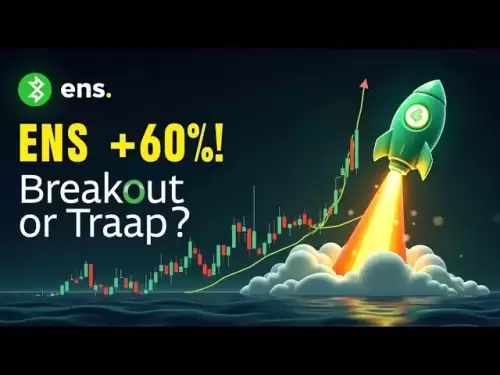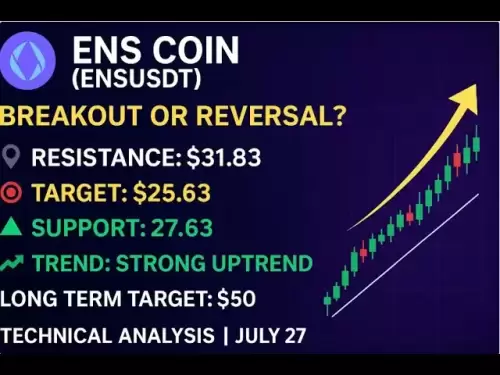-
 Bitcoin
Bitcoin $117900
0.31% -
 Ethereum
Ethereum $3766
0.28% -
 XRP
XRP $3.176
-0.31% -
 Tether USDt
Tether USDt $1.000
0.00% -
 BNB
BNB $795.6
1.51% -
 Solana
Solana $186.8
-1.09% -
 USDC
USDC $0.9999
-0.01% -
 Dogecoin
Dogecoin $0.2353
-1.33% -
 TRON
TRON $0.3226
1.49% -
 Cardano
Cardano $0.8172
-1.08% -
 Sui
Sui $4.178
3.06% -
 Hyperliquid
Hyperliquid $43.05
-3.39% -
 Stellar
Stellar $0.4367
-0.57% -
 Chainlink
Chainlink $18.62
1.47% -
 Hedera
Hedera $0.2828
6.63% -
 Bitcoin Cash
Bitcoin Cash $584.7
5.65% -
 Avalanche
Avalanche $24.81
2.53% -
 Litecoin
Litecoin $112.8
-0.88% -
 UNUS SED LEO
UNUS SED LEO $8.975
-0.08% -
 Shiba Inu
Shiba Inu $0.00001395
-1.07% -
 Toncoin
Toncoin $3.285
-1.05% -
 Ethena USDe
Ethena USDe $1.001
0.01% -
 Polkadot
Polkadot $4.123
0.76% -
 Uniswap
Uniswap $10.49
-0.18% -
 Monero
Monero $326.5
0.14% -
 Dai
Dai $0.9999
-0.02% -
 Bitget Token
Bitget Token $4.576
0.34% -
 Pepe
Pepe $0.00001247
-1.55% -
 Cronos
Cronos $0.1400
3.77% -
 Aave
Aave $295.1
-0.73%
Does USDT support direct exchange with fiat currency?
USDT doesn't directly exchange with fiat; instead, users utilize exchanges or P2P platforms, incurring varying fees and risks depending on the chosen method and platform's security and regulation compliance.
Feb 28, 2025 at 02:49 pm
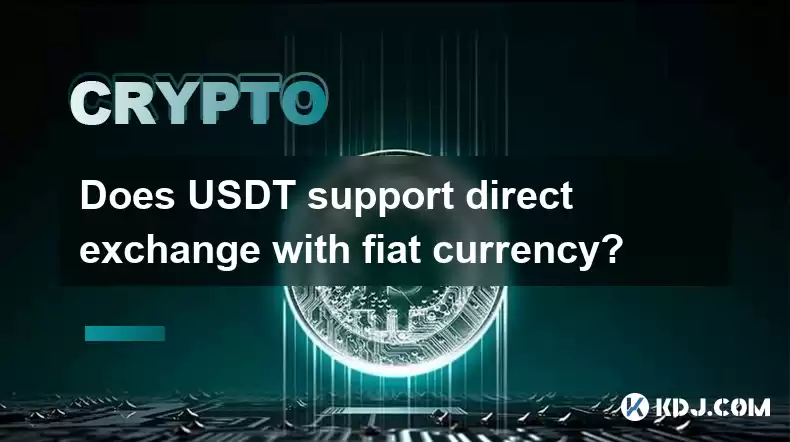
Does USDT Support Direct Exchange with Fiat Currency? A Deep Dive into Tether's Fiat On- and Off-Ramp Options
Key Points:
- USDT, while pegged to the US dollar, doesn't offer direct exchange with fiat currency in a single, universal transaction. The process involves intermediaries and varies significantly depending on the exchange platform used.
- Numerous cryptocurrency exchanges facilitate USDT trading against fiat currencies like USD, EUR, GBP, and others. The specific methods and fees differ between these exchanges.
- Peer-to-peer (P2P) platforms provide alternative avenues for USDT-fiat exchanges, but these often involve higher risks and fees, and may lack regulatory oversight.
- Understanding the nuances of each exchange, including its fees, security measures, and regulatory compliance, is crucial before undertaking USDT-fiat transactions.
- The availability of direct fiat on-ramps and off-ramps for USDT can also depend on geographic location and regulatory restrictions.
Exploring USDT Fiat On- and Off-Ramp Options
The question of whether USDT directly supports exchange with fiat currency is nuanced. While Tether, the issuer of USDT, aims for a 1:1 peg with the US dollar, the actual exchange process isn't a direct, single-step transaction like exchanging dollars for euros at a bank. Instead, it involves several intermediaries and processes, which vary significantly depending on the chosen platform.
- Cryptocurrency Exchanges as Intermediaries: The most common method to exchange USDT for fiat currency, and vice-versa, is through cryptocurrency exchanges. These exchanges act as intermediaries, facilitating the conversion. For instance, if you want to exchange your USDT for USD, you'd first need to deposit your USDT into an account on a supporting exchange. This exchange would then allow you to sell your USDT for USD, typically via a trading pair like USDT/USD. The USD would then be available for withdrawal to your linked bank account. The process is reversed for converting fiat to USDT. However, it's crucial to note that the availability of fiat currency options and the specific fiat currencies supported vary considerably between exchanges. Some exchanges might only support USD, while others might offer EUR, GBP, JPY, and other major currencies. Furthermore, the fees charged for these transactions differ between exchanges, as do the withdrawal limits and processing times. Factors such as verification requirements (KYC/AML) also vary, with some exchanges demanding more stringent verification than others. It’s essential to research multiple exchanges before selecting one, comparing their fees, security features, reputation, and regulatory compliance to find the best option for your needs. Choosing a reputable and well-established exchange significantly reduces the risk of scams and unauthorized access to your funds. Understanding the exchange's security protocols, including two-factor authentication (2FA) and cold storage of assets, is equally important. The exchange's customer support responsiveness and its history of handling user issues are also crucial factors to consider. Finally, researching the regulatory environment in your jurisdiction and selecting an exchange that complies with relevant laws and regulations minimizes legal risks.
- Peer-to-Peer (P2P) Platforms: P2P platforms offer an alternative route for exchanging USDT and fiat currency. These platforms connect buyers and sellers directly, often bypassing traditional exchanges. You might find individuals willing to buy your USDT using fiat currency, or vice versa. While P2P platforms can sometimes offer competitive rates, they usually involve higher risks. These risks stem from the lack of centralized oversight and the potential for scams or fraud. Verifying the trustworthiness of the counterparty is paramount, and careful scrutiny of their reputation and transaction history is essential. Furthermore, P2P platforms often lack the robust security measures found on regulated exchanges, increasing the vulnerability to hacking or theft. In many jurisdictions, P2P platforms operate in a less regulated environment than traditional exchanges, potentially leaving users with limited recourse in case of disputes or fraudulent activities. Therefore, engaging in P2P transactions requires a higher degree of caution and due diligence than using established exchanges. It's crucial to prioritize security, using secure communication channels and payment methods to mitigate risks. Thoroughly researching the reputation of the platform and its users before initiating any transaction is crucial to minimize potential losses.
- Payment Processors and Specialized Services: Some payment processors and specialized services facilitate USDT-fiat exchanges. These services often integrate with cryptocurrency exchanges or act as independent bridges between the crypto and fiat worlds. They might offer features like debit card purchases of USDT or bank transfers for selling USDT. However, these services typically charge higher fees compared to direct exchange on major exchanges. The convenience they offer comes at a cost. Understanding their fee structures and processing times is essential before using them. It's also important to investigate their security measures and regulatory compliance to ensure the safety of your funds. Like any financial service, verifying the legitimacy and trustworthiness of the provider is crucial before entrusting them with your assets.
- Geographic Limitations and Regulatory Factors: The availability of direct fiat on-ramps and off-ramps for USDT can significantly vary based on geographic location and local regulations. In some jurisdictions, stringent regulatory frameworks might restrict or limit the operation of cryptocurrency exchanges, impacting the accessibility of USDT-fiat exchanges. In other regions, the legal status of cryptocurrencies might be unclear, creating uncertainties for users seeking to convert USDT to fiat currency or vice versa. Understanding the legal landscape in your specific location is essential before undertaking any USDT-fiat transaction. Non-compliance with local regulations can lead to legal repercussions. Therefore, researching the legal status of cryptocurrencies and the regulatory environment surrounding cryptocurrency exchanges in your region is a crucial step before engaging in such transactions.
FAQs
Q: Are there any fees involved in exchanging USDT for fiat currency?
A: Yes, fees are typically involved. These fees vary depending on the exchange platform, the payment method used, and the transaction volume. Fees can include trading fees, withdrawal fees, and potentially network fees (gas fees). Always check the fee structure of the platform before initiating a transaction.
Q: How secure is exchanging USDT for fiat currency?
A: The security of exchanging USDT for fiat currency depends heavily on the platform used. Reputable exchanges generally employ robust security measures, including two-factor authentication (2FA), cold storage of assets, and advanced encryption techniques. However, P2P platforms often present higher security risks due to the lack of centralized oversight. It is crucial to select a platform with a strong security reputation and to practice good security hygiene, such as using strong passwords and avoiding phishing scams.
Q: Is exchanging USDT for fiat currency legal in my country?
A: The legality of exchanging USDT for fiat currency varies significantly across different jurisdictions. Some countries have embraced cryptocurrencies and established clear regulatory frameworks, while others have implemented restrictions or outright bans. It's essential to research the legal status of cryptocurrencies and the relevant regulations in your specific country before engaging in any transactions. Failure to comply with local laws can lead to legal consequences.
Q: What are the typical processing times for USDT-fiat exchanges?
A: Processing times vary depending on the platform and the chosen payment method. Reputable exchanges usually process transactions relatively quickly, often within a few hours or days. However, P2P transactions can take longer, and delays might occur due to various factors. Always check the estimated processing time provided by the platform.
Q: What are the risks associated with exchanging USDT for fiat currency?
A: Risks include exchange rate fluctuations (USDT's peg to the USD isn't always perfect), platform security breaches, scams, fraud, and regulatory uncertainty. Choosing reputable and secure platforms, practicing good security habits, and understanding the regulatory landscape can significantly mitigate these risks.
Disclaimer:info@kdj.com
The information provided is not trading advice. kdj.com does not assume any responsibility for any investments made based on the information provided in this article. Cryptocurrencies are highly volatile and it is highly recommended that you invest with caution after thorough research!
If you believe that the content used on this website infringes your copyright, please contact us immediately (info@kdj.com) and we will delete it promptly.
- Bitcoin, Ruvi AI, and CoinMarketCap: Navigating the Future of Crypto
- 2025-07-28 02:30:12
- Dogwifhat (WIF) Eyes Bullish Breakout: Can It Breach $1.20?
- 2025-07-28 02:50:12
- Bitcoin Bounces: How the US-China Tariff Truce Impacts Crypto
- 2025-07-28 02:50:12
- Bitcoin Bull Market: Price Targets and Expert Takes
- 2025-07-28 02:30:12
- Cardano Price Rockets: ADA Jumps Past Resistance, $2 Target in Sight?
- 2025-07-28 01:30:14
- Ruvi AI: The Next Solana? Riding the AI Token Wave on CoinMarketCap
- 2025-07-28 00:50:16
Related knowledge
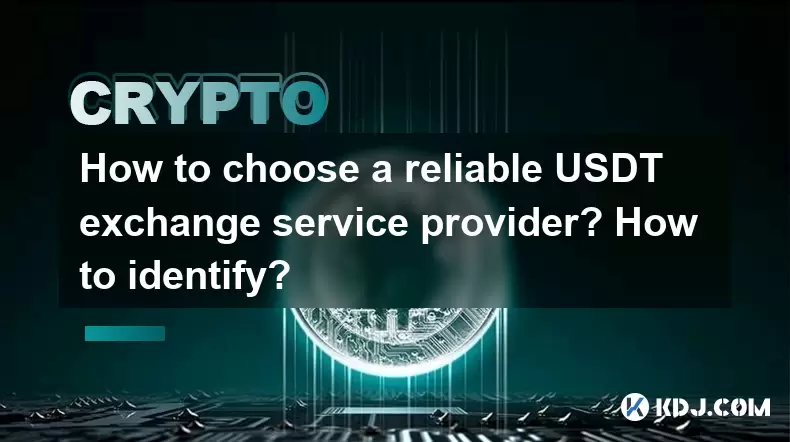
How to choose a reliable USDT exchange service provider? How to identify?
Jun 12,2025 at 03:15pm
Understanding the Role of USDT in Cryptocurrency TradingUSDT (Tether) is one of the most widely used stablecoins in the cryptocurrency market. It is d...
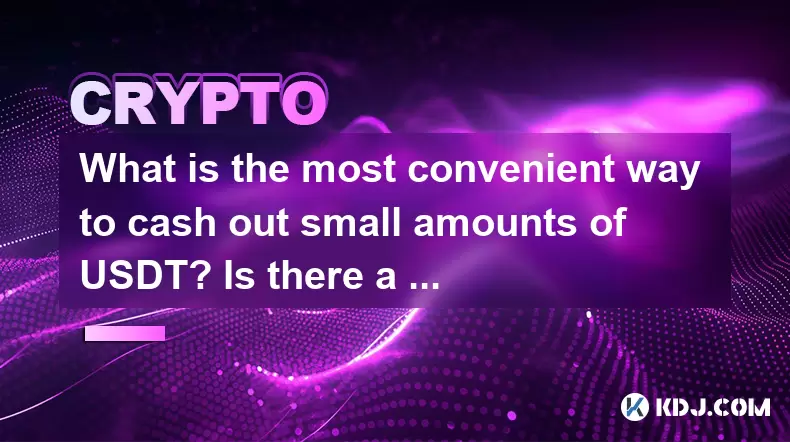
What is the most convenient way to cash out small amounts of USDT? Is there a shortcut?
Jun 11,2025 at 11:00pm
Understanding the Need to Cash Out Small USDT AmountsCashing out small amounts of USDT can be a challenge for many crypto users. Traditional methods o...
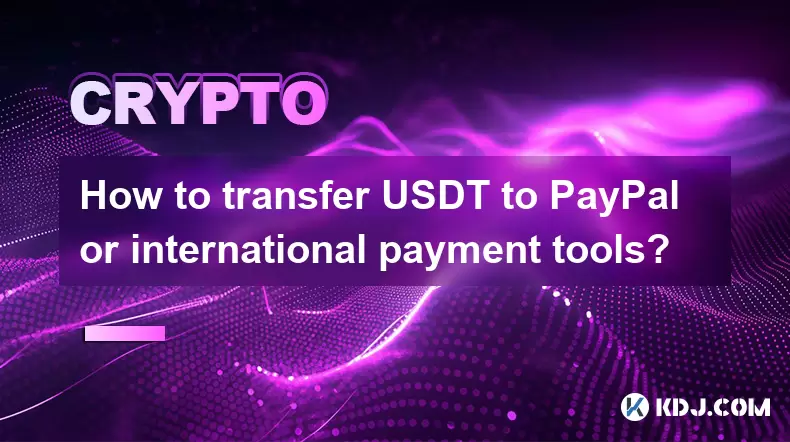
How to transfer USDT to PayPal or international payment tools?
Jun 15,2025 at 05:28am
Understanding the Basics of USDT and PayPal IntegrationUSDT (Tether) is a stablecoin pegged to the US dollar, offering blockchain-based value transfer...
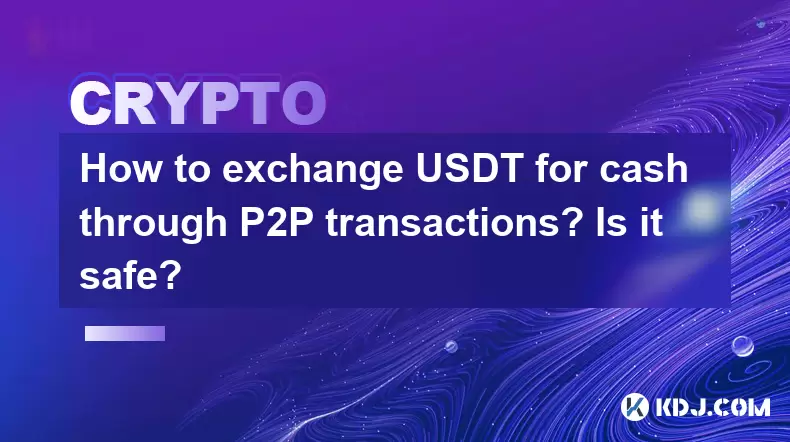
How to exchange USDT for cash through P2P transactions? Is it safe?
Jun 18,2025 at 07:56am
Understanding USDT and P2P TransactionsTether (USDT) is a stablecoin pegged to the value of the US dollar, making it a popular choice for users who wa...
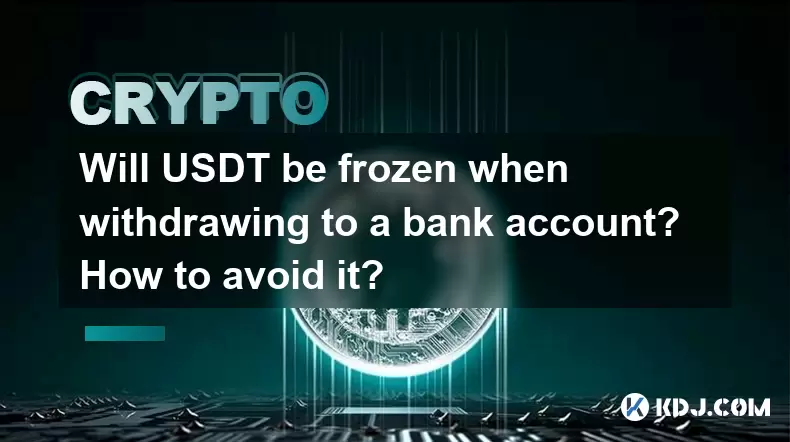
Will USDT be frozen when withdrawing to a bank account? How to avoid it?
Jun 15,2025 at 10:03am
Understanding USDT Withdrawals and Bank Account Freezing RisksWhen users decide to withdraw USDT (Tether) to a bank account, one of the most common co...
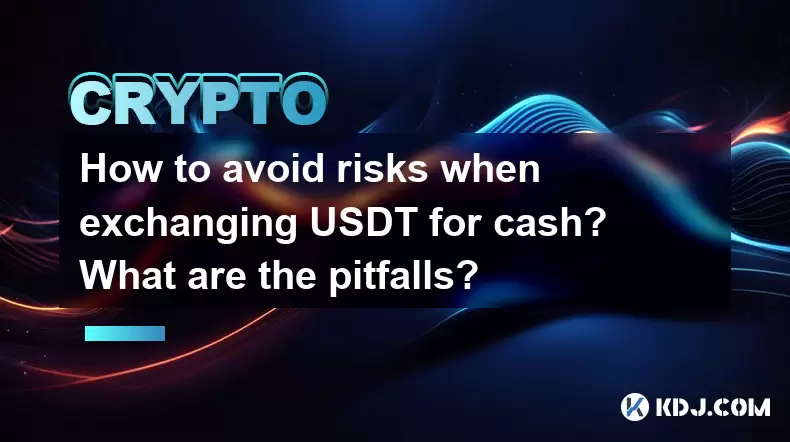
How to avoid risks when exchanging USDT for cash? What are the pitfalls?
Jun 11,2025 at 08:14pm
Understanding the Risks of Exchanging USDT for CashWhen exchanging USDT (Tether) for cash, users must be aware of the potential risks involved. As a s...

How to choose a reliable USDT exchange service provider? How to identify?
Jun 12,2025 at 03:15pm
Understanding the Role of USDT in Cryptocurrency TradingUSDT (Tether) is one of the most widely used stablecoins in the cryptocurrency market. It is d...

What is the most convenient way to cash out small amounts of USDT? Is there a shortcut?
Jun 11,2025 at 11:00pm
Understanding the Need to Cash Out Small USDT AmountsCashing out small amounts of USDT can be a challenge for many crypto users. Traditional methods o...

How to transfer USDT to PayPal or international payment tools?
Jun 15,2025 at 05:28am
Understanding the Basics of USDT and PayPal IntegrationUSDT (Tether) is a stablecoin pegged to the US dollar, offering blockchain-based value transfer...

How to exchange USDT for cash through P2P transactions? Is it safe?
Jun 18,2025 at 07:56am
Understanding USDT and P2P TransactionsTether (USDT) is a stablecoin pegged to the value of the US dollar, making it a popular choice for users who wa...

Will USDT be frozen when withdrawing to a bank account? How to avoid it?
Jun 15,2025 at 10:03am
Understanding USDT Withdrawals and Bank Account Freezing RisksWhen users decide to withdraw USDT (Tether) to a bank account, one of the most common co...

How to avoid risks when exchanging USDT for cash? What are the pitfalls?
Jun 11,2025 at 08:14pm
Understanding the Risks of Exchanging USDT for CashWhen exchanging USDT (Tether) for cash, users must be aware of the potential risks involved. As a s...
See all articles





















